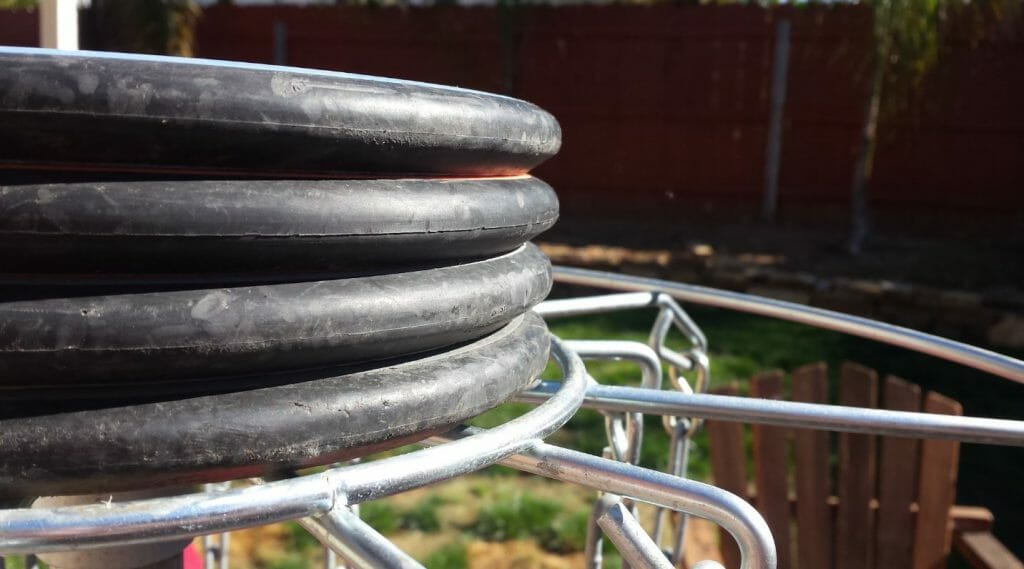Make those hours on the basket truly count with a couple helpful reminders
April 11, 2017 by Conor Boland in Instruction with 2 comments

Nothing shaves strokes off a tournament round like a dedicated putting routine. After a few years of playing casually, I decided to get serious and bought a basket of my own. Practicing my putting game on a daily basis upped my performance like casual rounds and field work never could, but committing the time to practice putting did not guarantee instant improvement. For those of you who already have a basket and a stack of putters in your backyard, here are a few putting practice sins you might be guilty of — because I was, too.
1) Lack of consistency
With all practice, consistency is key. If you hold a stack of putters in your hand during practice, do the same in your actual rounds. I like to approach my putts like a basketball player approaches a free throw: I step up the same way every time, with the same form, and take a large breath in and out before each putt. A consistent approach to each putt provides a mental touchstone and familiarity, allowing you to putt with authority and confidence every time.
It’s also helpful to simply have a big stack of putters. Developing a routine becomes difficult if you’re strolling to the basket every one or two putts. Owning more putters allows you to set up more intricate putting games and routines. I recommend having at least five identical putters. While this may be a burden for the McPro Aviar fans among you, most of you can pick up a stack of your favorite putter for relatively cheap. It’s an investment you won’t regret.
2) Too much consistency
When I got my first basket, I practiced constantly. But I found that while I improved at home, my newfound skills did not fully translate to the course. I was too easy on myself. When practicing, I lined myself straight up to the basket for 10-50 foot putts with no obstructions. While this strategy helped a bit, it did little to simulate the range of challenging putts a good course creates.
Toughen up your routine by adding in common obstacles. Putt behind a tree, or from behind your car. Try a few sequences of putting on one knee, or in a position that requires an extreme anhyzer putt. I like to set up my basket on my raised porch to simulate uphill putts. Sometimes I even place my basket at the bottom of my basement staircase and putt downhill. The course will not give you many easy breaks, so you can’t give them to yourself at home either.
3) Forgetting to have fun
This is supposed to be fun, remember? The only way to significantly improve is to throw thousands of putts, which gets monotonous if you don’t add some excitement to your routine. I like to develop small games or challenges for myself to keep things fresh. Try starting at 50 feet until you make one, and then step into 40, then 30, 20, and 10. Once you get all five try the reverse, and start over when you fail. I also like to do an around-the-world-style game, but with varying ranges and stances.
You can also bring a friend. Playing HORSE, or even a disc golf form of knockout, with a buddy helps add some stakes and bragging rights to your usual routine. Sometimes I arrange putters at different spots with assigned point values and try to establish and beat a high score. For a similar, more systematic routine, check out Matt Rothstein’s 1-Putter Practice Routine. An added benefit of such routines is simulating the pressure putts you’ll face in tournaments.
4) Being too proud to lay up
There’s nothing wrong with confidence, but it is also important to know your range. If you’re practicing from 50 feet out and notice the discs flying everywhere but the chains, it’s wise to practice laying up from that distance, as well. That way when you decide to avoid a death putt during a round, you’ll at least be prepared.
5) Practice with a positive attitude
You’re going to miss a ton of putts. Just like in a tournament, forgetting the last bad putt is crucial to a successful putting routine. Try to analyze and critique your failed putts with a mind for improvement, and not despair. If you’re having an off day, ask yourself what changed from your last session and address the issue. Don’t let a slew of missed putts cause you to quit or alter your routine, though. I always try to end my practice with at least five made putts in a row so I walk away with a positive attitude.
Remember: Great putting equalizes players who are unable to drive as far — or as accurately — as their opponents. And there’s no better feeling than stepping up to the furthest lie, smashing a huge putt with confidence, and strolling up the basket like it ain’t no thing.